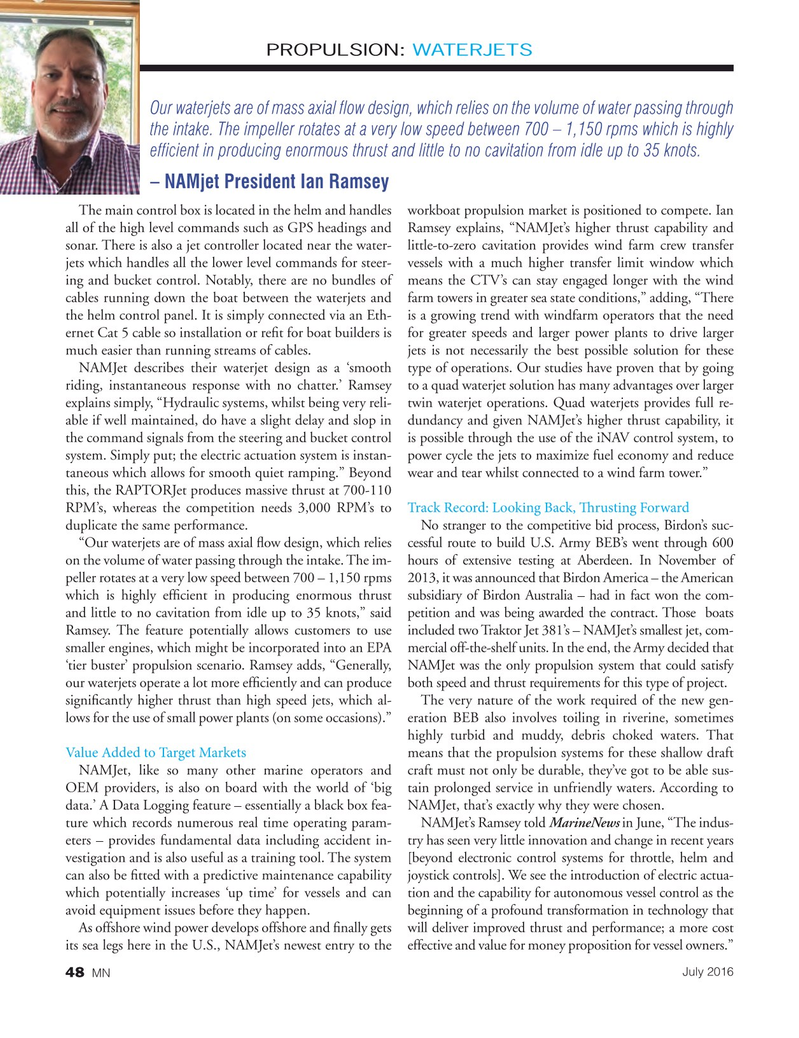
Page 48: of Marine News Magazine (July 2016)
Propulsion Technology
Read this page in Pdf, Flash or Html5 edition of July 2016 Marine News Magazine
PROPULSION: WATERJETS
Our waterjets are of mass axial ? ow design, which relies on the volume of water passing through the intake. The impeller rotates at a very low speed between 700 – 1,150 rpms which is highly ef? cient in producing enormous thrust and little to no cavitation from idle up to 35 knots. – NAMjet President Ian Ramsey
The main control box is located in the helm and handles workboat propulsion market is positioned to compete. Ian all of the high level commands such as GPS headings and Ramsey explains, “NAMJet’s higher thrust capability and sonar. There is also a jet controller located near the water- little-to-zero cavitation provides wind farm crew transfer jets which handles all the lower level commands for steer- vessels with a much higher transfer limit window which ing and bucket control. Notably, there are no bundles of means the CTV’s can stay engaged longer with the wind cables running down the boat between the waterjets and farm towers in greater sea state conditions,” adding, “There the helm control panel. It is simply connected via an Eth- is a growing trend with windfarm operators that the need ernet Cat 5 cable so installation or re? t for boat builders is for greater speeds and larger power plants to drive larger much easier than running streams of cables. jets is not necessarily the best possible solution for these
NAMJet describes their waterjet design as a ‘smooth type of operations. Our studies have proven that by going riding, instantaneous response with no chatter.’ Ramsey to a quad waterjet solution has many advantages over larger explains simply, “Hydraulic systems, whilst being very reli- twin waterjet operations. Quad waterjets provides full re- able if well maintained, do have a slight delay and slop in dundancy and given NAMJet’s higher thrust capability, it the command signals from the steering and bucket control is possible through the use of the iNAV control system, to system. Simply put; the electric actuation system is instan- power cycle the jets to maximize fuel economy and reduce taneous which allows for smooth quiet ramping.” Beyond wear and tear whilst connected to a wind farm tower.” this, the RAPTORJet produces massive thrust at 700-110
RPM’s, whereas the competition needs 3,000 RPM’s to Track Record: Looking Back, T rusting Forward duplicate the same performance. No stranger to the competitive bid process, Birdon’s suc- “Our waterjets are of mass axial ? ow design, which relies cessful route to build U.S. Army BEB’s went through 600 on the volume of water passing through the intake. The im- hours of extensive testing at Aberdeen. In November of peller rotates at a very low speed between 700 – 1,150 rpms 2013, it was announced that Birdon America – the American which is highly ef? cient in producing enormous thrust subsidiary of Birdon Australia – had in fact won the com- and little to no cavitation from idle up to 35 knots,” said petition and was being awarded the contract. Those boats
Ramsey. The feature potentially allows customers to use included two Traktor Jet 381’s – NAMJet’s smallest jet, com- smaller engines, which might be incorporated into an EPA mercial off-the-shelf units. In the end, the Army decided that ‘tier buster’ propulsion scenario. Ramsey adds, “Generally, NAMJet was the only propulsion system that could satisfy our waterjets operate a lot more ef? ciently and can produce both speed and thrust requirements for this type of project.
signi? cantly higher thrust than high speed jets, which al- The very nature of the work required of the new gen- lows for the use of small power plants (on some occasions).” eration BEB also involves toiling in riverine, sometimes highly turbid and muddy, debris choked waters. That
Value Added to Target Markets means that the propulsion systems for these shallow draft
NAMJet, like so many other marine operators and craft must not only be durable, they’ve got to be able sus-
OEM providers, is also on board with the world of ‘big tain prolonged service in unfriendly waters. According to data.’ A Data Logging feature – essentially a black box fea- NAMJet, that’s exactly why they were chosen. ture which records numerous real time operating param- NAMJet’s Ramsey told MarineNews in June, “The indus- eters – provides fundamental data including accident in- try has seen very little innovation and change in recent years vestigation and is also useful as a training tool. The system [beyond electronic control systems for throttle, helm and can also be ? tted with a predictive maintenance capability joystick controls]. We see the introduction of electric actua- which potentially increases ‘up time’ for vessels and can tion and the capability for autonomous vessel control as the avoid equipment issues before they happen. beginning of a profound transformation in technology that
As offshore wind power develops offshore and ? nally gets will deliver improved thrust and performance; a more cost its sea legs here in the U.S., NAMJet’s newest entry to the effective and value for money proposition for vessel owners.”
July 2016 48 MN
MN July16 Layout 32-49.indd 48 6/20/2016 4:17:23 PM

 47
47

 49
49
